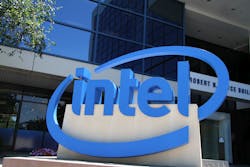Intel is stepping into the field of machine vision, a move that could help shift its processors into autonomous cars and industrial robots. The company said that it would buy Itseez, a Russian firm that develops computer vision software for embedded systems.
Intel has struggled to enter the markets for machine vision and autonomous cars. For years, the auto industry has proved tough to crack and Intel's automotive chips have been confined to things like dashboard displays and wireless connectivity. In particular, the company has been slowed down by the same strict reliability standards that have held back companies like Qualcomm.
But trying to wean itself out of the market for personal computers, Intel has been quietly inching toward more automotive technology.
In April, Intel acquired Yogitech, a company that designs functional safety software for automotive electronics and factory equipment. Yogitech’s software ensures that the processors inside things like autonomous cars and factory equipment are working correctly and sends alerts to operators when they aren't.
Around the same time, Wind River, an embedded software maker that Intel acquired in 2009, said that it was adding new products to help automakers make wireless updates to their vehicles. Auto companies could use their technology to automatically swap out firmware or machine vision software in their cars.
Intel said that the impetus behind buying Itseez was to help its customers integrate software that can acquire, process, and analyze images. In addition to automotive software, Itseez has also built products for analyzing the intimate details of a person’s face, along with a mobile app for creating three-dimensional scans of people and objects.
Itseez, which was founded by former Intel employees in 2005, will be folded into the chipmaker’s Internet of Things Group — the fastest growing business within Intel, according to its first quarter financial results. Their software will support Intel projects ranging from autonomous driving and security systems to factory robots that sort and assemble products.
“This acquisition furthers Intel’s efforts to win in IoT market segments like automotive and video, where the ability to electronically perceive and understand images paves the way for innovation,” Doug Davis, senior vice president and general manager of Intel’s Internet of Things Group, wrote in a blog post. The terms of the deal were not mentioned.
Itseez also works on defining computer vision standards like OpenCV, an open-source software library. The company has also worked closely with OpenVX, a collection of machine vision code that companies like Nvidia and Advanced Micro Devices have customized for their own hardware.
Buying into machine vision software is the latest evidence of Intel’s conversion into a cloud computing and Internet of Things company. Last month, Intel outlined plans to eliminate 12,000 jobs, mostly related to its personal computer business, as part of a larger restructuring effort. Meanwhile, Intel executives have said that its acquisition of Altera would help the company shift into new markets.
As part of that deal, Intel acquired a wide range of field-programmable gate arrays (FPGAs), a type of processor that can be altered based on the application. The company is already pairing its FPGAs with computer chips to better handle specialized cloud computing tasks in data centers.
This combination of processors is also being tried out by companies looking to integrate artificial intelligence into their cloud services. Microsoft and China’s Baidu have both built custom FPGAs that carry out the intensive calculations required by machine learning.
Brian Krzanich, Intel’s chief executive, has shared his plans to put FPGA accelerators into automobiles, where they would merge sensor data from cameras and radars to generate models of the car's surroundings. FPGAs have been widely used to increase the speed at which computers can process images, making them ideal for things like warning drivers when other cars enter their blind spot.
The market for similar technology that combines machine vision and artificial intelligence is growing very competitive. NXP Semiconductors recently revealed its computing platform for sensor fusion, while Mobileye shared the blueprints for the next generation of its flagship machine vision chip.
Looking for parts? Go to SourceESB
About the Author
James Morra
Senior Editor
James Morra is the senior editor for Electronic Design, covering the semiconductor industry and new technology trends, with a focus on power electronics and power management. He also reports on the business behind electrical engineering, including the electronics supply chain. He joined Electronic Design in 2015 and is based in Chicago, Illinois.


